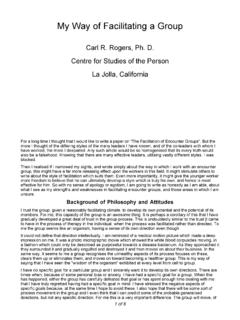Transcription of OD Interventions or “Help! What Do I Do Now?” - bogda.com
1 OD Interventions or help ! what do I Do Now? Organization Development and Consulting: Perspectives and Foundations,Fred Massarik and Marissa Pei-Carpenter, eds. Jossey-Bass/Pfeiffer, 2002. 2004 Ginger Lapid-Bogda, (310) 829-3309 Interventions or help ! what Do I Do Now? By Ginger Lapid-BogdaThe most complex display of the variety of Interventions used by organization development consultantscan be found in Blake and Mouton s (1983) Consulcube from their book Consultation. This three-dimensional cube looks at who the client is (called units of change ), the consultation style used ( kinds ofinterventions ), and problem(s) diagnosed ( focal issues ). See the layout of ChangeKind of InterventionsFocal Issuesindividualacceptantpower/authority groupcatalyticmorale/cohesionintergroupc onfrontationnorms/standardsorganizationp rescriptivegoals/objectiveslarger social systemtheory/principlesSchmuck and Mile (1976), in OD in Schools, construct an intervention cube that adds dyad/triad to the Units of Change dimension and role to Focal Issues.
2 The Schmuck and Miles Intervention Dimensionincludes consultant style and the process used by the consultant (that is, data feedback, processconsultation, task force establishment, and so forth). W. Warner Burke (1982) provides a readable narrativeof these and other intervention typologies in Organization Development: Principles & Practices. But do ODconsultants actually use cubes in making determinations about how to intervene in client systems? We mightuse one, after the fact, to describe what we ve done. We might also use a cube before an intervention toassess our options. However, the remaining sections of this paper depict more of what we actually do usinganalysis and intuition. They are, I think, the mind and guts of our DiagnosisConsultants have models, categories, and working theories (implicit and explicit) about howorganizations work, how people behave, and how change occurs. These help us and our clients make senseout of an otherwise chaotic world; without them we wouldn t know what questions to ask, how to organizedata, or how to engage in dialogue with a client about organization problems or growth.
3 These models alsolimit us as we leave elements out of our models. At one time I added strategy and positioning to myconceptual framework and later I added vision and the importance of leadership in setting vision andstrategic direction. Now that I look at these issues, I actually see them and work with them in most of myconsultations. In sum, we intervene where we see weaknesses and strengths, but what we see is determinedby the models we use. OD Interventions or help ! what do I Do Now? Organization Development and Consulting: Perspectives and Foundations,Fred Massarik and Marissa Pei-Carpenter, eds. Jossey-Bass/Pfeiffer, 2002. 2004 Ginger Lapid-Bogda, (310) 829-3309 SystemsThe organization diagnosis would tell us which part of the organization is in the most pain and,therefore, the most potentially motivated to work on change. The mottos, no pain, no gain and when youain t got nothing, you got nothing to lose apply here.
4 One client came to me with a presenting problem oflack of teamwork. The diagnosis stage indicated an all-out racial war. The issue behind this was a leadershipvacuum of ten years. But the obvious pain was in the racial conflicts, which is where the client memberswere first willing to do the InterventionsThe client and client system may need to experience something successful together before they arewilling to work on deeper, more powerful issues. Or the client may need to have a success with theconsultant before the client will use the consultant on a more complex or more expensive problem. I cameupon this latter aspect with a client who wanted to use me in an action research project after they had seenme do something. They, however, could think of nothing for me to do with them I was supposed to cometo a meeting with them and do something! After I got past my resentment at being on stage and mynervousness ( stage fright ), I worked with them to explore how the position they put me in reflected some otheir own issues and then discussed what they hoped might result from our working together.
5 I got AnalysisI first heard this term from Dick Beckhard in a presentation. As a problem area surfaces, it requires us toask, what is the cause of the problem? and then to ask the question again and again until you get to theroot problem. Once at the core, the intervention can begin. A large-scale contract presented our consultingteam with a presenting problem or morale. This was, however, a symptom of departmental chaos: everydepartment lacked coherent structure, policies, and communication systems. Behind this was the core issueof managerial competence and leadership. The managers were all very inexperienced and they feltneglected, at best, and victimized, at worst, by the parent organization. So we began our interventionthrough intensive management coaching and, during the group feedback segment of the action researchproject, the managers facilitated the meetings with the OD consultant in the role of coach and backupsupport. This was done to enable the managers to be proactive at each MethodWhile this sounds like the domino analysis, it is quiet different.
6 In the backup method , the consultantis the stage director. Here, the consultant asks, If this intervention is to be successful, what other elementsmust be in place? These elements are not core problems; they simply help things along. A recent contractfor a three-day retreat with a management team of thirty people focused on direction and purpose for an OD Interventions or help ! what do I Do Now? Organization Development and Consulting: Perspectives and Foundations,Fred Massarik and Marissa Pei-Carpenter, eds. Jossey-Bass/Pfeiffer, 2002. 2004 Ginger Lapid-Bogda, (310) 829-3309 organization. Backing up , my co-consultant and I met with the leadership pair for a consultation toexplore their individual and common values and visions in preparation for their presentation at the also requested that the managers do some preparation regarding their visions and values for theirdepartments. These backup Interventions allowed the retreat experience to become more thoroughreflective, and Successes and FailuresIn determining an appropriate intervention for an organization with a particular problem, an assessmentof the organization s history of OD successes and failures can tell the consultant what might and might notwork with the client.
7 It can tell you what may be the effect of a certain process, as well as what type of haloeffect an intervention may have, simply because it is similar in method to a prior positive or negativeintervention an example, a human resource group with whom I consult requested a team-building retreat. Theobvious question was why they wanted it. The answer given was that they felt they needed it. As I exploredwith them why their prior experience has been negative, two themes emerged: the agenda had been themanager s, not the group s, and the consultant had colluded with the department in not facing highlyconflicting issues. As a result of this information (and so as not to encourage a negative halo effect ), theintervention design was as follows: (1) generate the issues needing attention by having each group memberanonymously complete two 3 x 5 cards the first card answered the question, what two or three issuesdo we need to deal with that would be easy for us?
8 And the second card responded to the question, Whattwo or three areas do we need to address as a group that are difficult for us to deal with but which wouldadd great value to our organization if we could deal with them effectively? ; (2) collect the cards and readthem out loud; (3) divide the group into small groups of three or four people and have each group design thenext two days; (4) compare and combine designs according to group consensus; (5) negotiate the consultantrole regarding confrontational consultant behavior (which they preferred to call gutsy ); and (6) do Strength and StretchAt the negative extreme of consultant strength would be the consultant who is so specialized that everyconsultation intervention, no matter what the client needs, is, for example, quality circles, teambuilding, or work redesign. At the extreme of consultant stretch is the consultant who has been wantingto try an intervention so that the next client, regardless of the organizational issues, receives thatintervention.
9 The extremes aside, most competent consultants do factor strength and stretch into theirpractices. My own example feels like true confessions of a consultant. I am quite adept at group process(strength) and have a limited attention span (forty-five-minute intervals at best) for facilitating task-onlyproblem solving meetings (weakness). Consequently, if the client needs task-specific group problem solving,I often break participants into small groups where they facilitate themselves, or I coach the head of the group OD Interventions or help ! what do I Do Now? Organization Development and Consulting: Perspectives and Foundations,Fred Massarik and Marissa Pei-Carpenter, eds. Jossey-Bass/Pfeiffer, 2002. 2004 Ginger Lapid-Bogda, (310) 829-3309 task-specific meeting leadership and then support the leader through process consultation and make task-related Interventions only when the group gets stuck. My true confession relates to stretch: with any clientI always look for some way(s) to do something new.
10 I look for what is unique about the client and theclient s issues to assess how I can be creative and stimulated. This approach, I think, keeps me vital andauthentic as a consultant and person. The above items are beginning explorations of what I think realconsultants do. They do not use cubes or any other mechanistic categorization of Interventions as a prioricategories. They develop congruent approaches from experience, reading, talking with colleagues, and self-reflection. In doing the self-reflection, I realized that I believe an intervention actually starts when the clientmake the decision to act by calling the consultant. Consequently, the intervention stage doesn t occur afterdiagnosis, but starts with the initial call. Peter Block (2000) explores these early Interventions in FlawlessConsulting, particularly those related to contracting and resistance. In all this our own styles as uniquehuman beings are basic.







